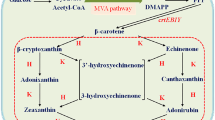Abstract
Seven Escherichia coli strains, which were metabolically engineered with carotenoid biosynthetic pathways, were systematically compared in order to investigate the strain-specific formation of carotenoids of structural diversity. C30 acyclic carotenoids, diaponeurosporene and diapolycopene were well produced in all E. coli strains tested. However, the C30 monocyclic diapotorulene formation was strongly strain dependent. Reduced diapotorulene formation was observed in the E. coli strain Top10, MG1655, and MDS42 while better formation was observed in the E. coli strain JM109, SURE, DH5a, and XL1-Blue. Interestingly, C40 carotenoids, which have longer backbones than C30 carotenoids, also showed strain dependency as C30 diapotorulene did. Quantitative analysis showed that the SURE strain was the best producer for C40 acyclic lycopene, C40 dicyclic β-carotene, and C30 monocyclic diapotorulene. Of the seven strains examined, the highest volumetric productivity for most of the carotenoids structures was observed in the recombinant SURE strain. In conclusion, we showed that recombinant hosts and carotenoid structures influenced carotenoid productions significantly, and this information can serve as the basis for the subsequent development of microorganisms for carotenoids of interest.






Similar content being viewed by others
References
Lee, P. C., & Schmidt-Dannert, C. (2002). Applied Microbiology and Biotechnology, 60, 1–11.
Vershinin, A. (1999). Biofactors, 10, 99–104.
Johnson, E., & Schroeder, W. (1995). Advances in Biochemical Engineering/Biotechnology, 53, 119–178.
Lee, P. C., Momen, A. Z. R., Mijts, B. N., & Schmidt-Dannert, C. (2003). Chemistry & Biology, 10, 453–462.
Mijts, B. N., Lee, P. C., & Schmidt-Dannert, C. (2005). Chemistry & Biology, 12, 453–460.
Ye, R. W., Yao, H., Stead, K., Wang, T., Tao, L., Cheng, Q., et al. (2007). Journal of Industrial Microbiology & Biotechnology, 34, 289–299.
Tao, L., Yao, H., & Cheng, Q. (2007). Gene, 386, 90–97.
Lee, P. C., Yoon, Y. G., & Schmidt-Dannert, C. (2009). Journal of Biotechnology, 140, 227–233.
Bhataya, A., Schmidt-Dannert, C., & Lee, P. C. (2009). Process Biochemistry, 44, 1095–1102.
Das, A., Yoon, S. H., Lee, S. H., Kim, J. Y., Oh, D. K., & Kim, S. W. (2007). Applied Microbiology and Biotechnology, 77, 505–512.
Lee, P. C., Mijts, B. N., & Schmidt-Dannert, C. (2004). Applied Microbiology and Biotechnology, 65, 538–546.
Farmer, W. R., & Liao, J. C. (2000). Nature Biotechnology, 18, 533–537.
Matthews, P. D., & Wurtzel, d E T. (2000). Applied Microbiology and Biotechnology, 53, 396–400.
Yoon, S. H., Park, H. M., Kim, J. E., Lee, S. H., Choi, M. S., Kim, J. Y., et al. (2007). Biotechnology Progress, 23, 599–605.
Yoon, S. H., Lee, Y. M., Kim, J. E., Lee, S. H., Lee, J. H., Kim, J. Y., et al. (2006). Biotechnology and Bioengineering, 94, 1025–1032.
Kupisz, K., Sujak, A., Patyra, M., Trebacz, K., & Gruszecki, W. I. (2008). BBA-Biomembranes, 1778, 2334–2340.
Kim, S. W., & Keasling, J. D. (2001). Biotechnology and Bioengineering, 72, 408–415.
Kim, J., Kong, M. K., & Lee, P. C. (2010). World Journal of Microbiology & Biotechnology. doi:10.1007/s11274-010-0408-5.
Britton, G., Liaaen-Jensen, S., Pfander, H. (1995). Birkhauser, Basel.
Schmidt-Dannert, C., Lee, P., & Mijts, B. (2006). Phytochemistry Reviews, 5, 67–74.
Lee, J., Sung, B., Kim, M., Blattner, F., Yoon, B., Kim, J., et al. (2009). Microbial Cell Factories, 8, 2.
Yoshikuni, Y., Dietrich, J. A., Nowroozi, F. F., Babbitt, P. C., & Keasling, J. D. (2008). Chemistry & Biology, 15, 607–618.
Yu, B. J., Sung, B. H., Koob, M. D., Lee, C. H., Lee, J. H., Lee, W. S., et al. (2002). Nature Biotechnology, 20, 1018–1023.
Acknowledgments
This work was supported by National Research Foundation of Korea Grant funded by the Korean Government (2009-0066612 and NRF-2009-C1AAA001-2009-0093062). This work was also supported by Priority Research Centers Program through the National Research Foundation of Korea (NRF) funded by the Ministry of Education, Science and Technology (2009-0093826).
Author information
Authors and Affiliations
Corresponding author
Rights and permissions
About this article
Cite this article
Chae, H.S., Kim, KH., Kim, S.C. et al. Strain-Dependent Carotenoid Productions in Metabolically Engineered Escherichia coli . Appl Biochem Biotechnol 162, 2333–2344 (2010). https://doi.org/10.1007/s12010-010-9006-0
Received:
Revised:
Accepted:
Published:
Issue Date:
DOI: https://doi.org/10.1007/s12010-010-9006-0



